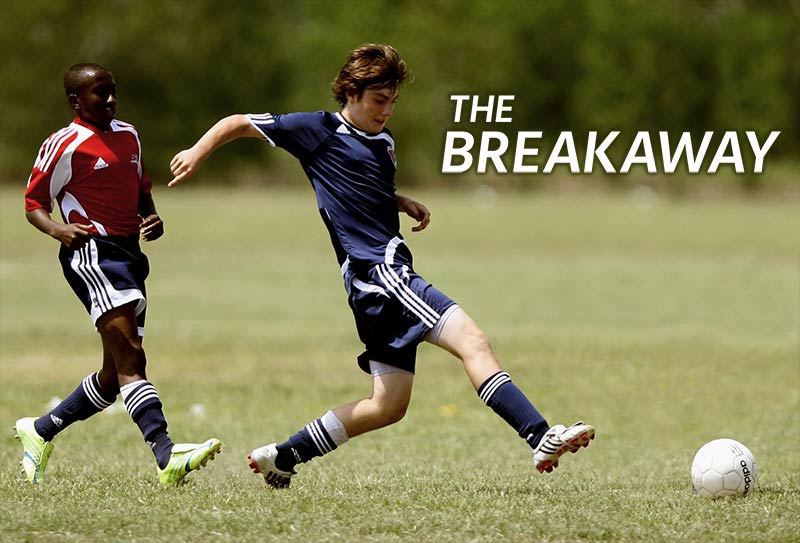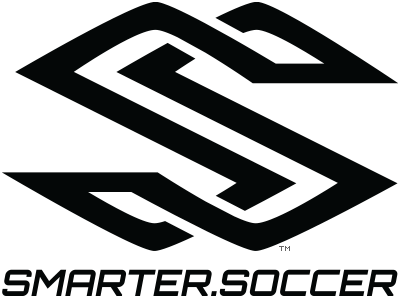BREAKAWAY
➤ Breakaway
Definition: When an attacker with the ball escapes from the opposing team’s defenders to go one-on-one with the goalie for a scoring opportunity.
The Breakaway is one of the most exciting moments in a soccer game. A lone attacker takes possession of the ball, eludes the defenders who are giving chase, and goes one-on-one with the goalkeeper. This either results in a dramatic goal, a save by the goalie, or a heroic tackle by one of the pursuing defenders.
Breakaways are not a rarity. They happen at all levels of play from the youngest players to the pros. There is at least one breakaway in every game and sometimes many more at the youth level. With the emphasis on counter-attacking these days, breakaways are happening at even more frequency. However, breakaways are rarely practiced in training. Why?

Whether you’re a defender or an attacker or a goalkeeper, smarter soccer players know that understanding how to perform when a breakaway occurs will give you a distinctive advantage. For example, should a goalkeeper come out of their net to cut down the angle during a breakaway. You bet! Should an attacker shoot high or low on a breakaway? Low! Should a defender tackle the attacker from behind risking a foul, or should they try and get in front of the ball and block the shot? Block the shot!
However, you’re not going to know any of this unless your coach (or Smarter Soccer) tells you. And you must practice breakaways over and over and over. Like anything in soccer, in order to get really good at something, you have to dedicate time to practice this skill.
➤ Big Pressure
In addition, a breakaway is one of the only times in soccer when the crowd (especially parents) are yelling at the top of their lungs for an extended period of time. So not only do you have to deal with the pressure of shooting, saving or defending, but you also have a lot of people yelling at you (usually all saying the same thing: “SHOOT!!!!” – ah, no kidding Mom. Not helping! ).
The player with the most pressure is clearly the attacker. He/She has the ball and is about to get sandwiched between the pursuing defenders and the goalie who is rushing out to close him/her down. Obviously, there’s not a lot of time to think about what you should do. That said, if you practice a few things, both physically and mentally, to keep it simple, you’ll significantly increase your chances of scoring.
First, take into account where the defenders are that are chasing you. You should have a pretty good idea from having awareness of where they were prior to you receiving the ball. Looking backwards will obviously slow you down, so you don’t want to do that, but remembering where they are and “feeling their presence” will give you a good sense.
Second, take a look up and see where you are on the field in relation to the goal. This will give you the opportunity to note where the goal is, as well as how the goalkeeper is advancing.
Third, make your move. More than likely the goalkeeper will be cutting the angle and heading directly towards you, but on occasion the goalie may have lost track of the goal, leaving it wide open. If this is the case, shoot low at the goal. Remember, you don’t have to kick the ball as hard as you can. Accuracy is what you’re after, since there is nobody back to block it.
Unfortunately, you don’t usually get that lucky and the goalie is coming right at you. Now is when you want to deliver a quick fake. And by quick, I mean a head/shoulder drop in one direction, and then one cut in the other direction to your dominant foot and shoot – Low! It’s a one-two punch. Not one touch, two touch…tackled. All you’re looking to do is “wrong foot” the goalie, and create a shooting lane. This is not the time for step-overs, scissors and any other elaborate moves that will delay your progress and allow the defenders to catch you.
➤ Once you shoot, one of four things will happen…
➔ You get the shot off on goal and you score. Time to celebrate with your teammates, especially the one that delivered you that quality pass to launch the breakaway.
➔ Two, the goalie saves the shot.
➔ Three, you get tackled from behind, usually because you took one too many touches to fake the goalie. Or…
➔ Four, the goalie blocks the shot or the ball gets poked away from you – but the ball is still up for grabs. Now is not the time to get mad at yourself because the shot wasn’t a success and throw your hands up in the air. Now is the time to try and collect the ball again for another attempt. Yes, you may be outnumbered, but remember all you need to do is find a narrow shooting lane and fire off another shot. The goal is open. Don’t – Stop – Playing.

Breakaways are rarely practiced in training.

F.01
Know Thy Field…
For Breakaways!
Summary
A playing surface isn’t so simple as grass and dirt. When you get to the field for a game, take a few moments to evaluate the entire field.
Remember when we discussed field quality in Know Thy Field? Well, do you think the playing surface would be something that would impact breakaways?
Of course!
★ Smarter.Soccer Insight: Long, thick grass on the field? That’s going to slow – you – way – down. Hard dirt field? That’s going to make the ball move fast, but can be unpredictable if it hits a bump. Wet conditions? Can be slow or fast, or both! Always take a moment to investigate the field before game time. The better you understand the field conditions, the better decisions you’ll be able to make when the pressure is on…like in a breakaway.

